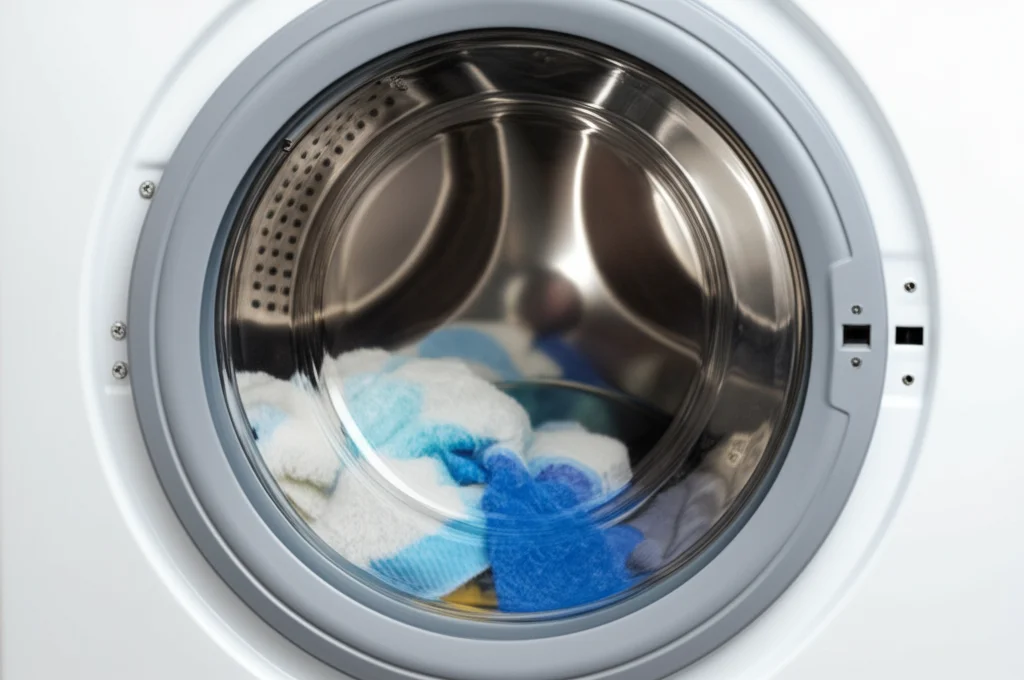· Laundry · 7 min read
How To Use A Washing Machine

How To Use A Washing Machine: A Complete Guide
Ever stared at your washing machine, feeling a little overwhelmed by all the buttons and settings? You’re not alone! Knowing how to use a washing machine properly can seem daunting, but it doesn’t have to be. This guide will walk you through everything you need to know, from sorting your clothes to selecting the right cycle, ensuring your laundry comes out clean and fresh every time. We’ll cover all the basics of using a washing machine, making laundry day less of a chore.
Takeaway:
- Sort laundry by color, fabric type, and soil level.
- Measure detergent accurately to avoid residue.
- Understand washing machine cycles and choose the appropriate one.
- Clean your washing machine regularly to maintain performance.
Quick Answer:
To use a washing machine, sort your clothes, add detergent, select a cycle based on fabric type, and start the machine. Always check care labels and avoid overloading for best results.
1. Sorting Your Laundry: The First Step to Clean Clothes
Before you even think about touching the washing machine, sorting your laundry is crucial. This prevents colors from bleeding, protects delicate fabrics, and ensures everything gets cleaned effectively. It’s a simple step that makes a huge difference in the longevity and appearance of your clothes. Think of it as setting the stage for a successful wash.
Here’s how to sort:
- By Color: Separate whites, lights, and darks. This prevents dye transfer, keeping your whites bright and your darks from fading.
- By Fabric Type: Wash delicate items (like lingerie or silk) separately from heavier items (like jeans or towels). Different fabrics require different levels of agitation.
- By Soil Level: Heavily soiled items (like work clothes or muddy sports gear) should be washed separately to prevent spreading dirt to cleaner clothes.
- Check Pockets: Always, always check pockets for tissues, coins, or anything else that could cause damage or a mess.
2. Understanding Detergent: How Much is Enough?
Using the right amount of detergent is essential. Too little, and your clothes won’t get clean. Too much, and you’ll end up with residue on your clothes and potentially damage your washing machine. It’s a delicate balance, but easily achievable with a little attention.
- Read the Detergent Label: Detergent packaging provides guidelines on how much to use based on load size and soil level.
- HE Detergent for HE Machines: High-efficiency (HE) washing machines require HE detergent, which produces fewer suds. Using regular detergent in an HE machine can cause excessive sudsing and damage the machine. You can find more information about HE machines here.
- Liquid vs. Powder: Both liquid and powder detergents work well. Liquid detergents dissolve easily, while powder detergents are often more economical.
- Detergent Pods: Convenient, but ensure they dissolve completely, especially in cold water.
3. Decoding Washing Machine Cycles: What Does Each One Do?
Washing machines come with a variety of cycles, each designed for specific types of fabrics and cleaning needs. Understanding these cycles is key to getting the best results and protecting your clothes. Don’t be afraid to experiment to find what works best for your laundry.
- Normal/Regular: For everyday clothes that aren’t heavily soiled.
- Delicates/Gentle: For lingerie, silk, and other delicate fabrics. This cycle uses a slower agitation speed.
- Permanent Press: For wrinkle-resistant fabrics. It uses warm water and a slower spin cycle.
- Heavy Duty: For heavily soiled items like jeans, towels, and work clothes.
- Quick Wash: For lightly soiled items that need a quick refresh.
- Bulky Items/Bedding: For large items like comforters and blankets.
- Sanitize: Uses high temperatures to kill bacteria.
4. Loading the Washing Machine: Don’t Overload!
Overloading the washing machine is a common mistake. It prevents clothes from moving freely, resulting in a less effective wash and potentially damaging the machine. Give your clothes room to breathe!
- Fill Level: Don’t pack the drum too tightly. Clothes should have enough space to move around.
- Weight Capacity: Check your washing machine’s manual for its weight capacity.
- Distribute Evenly: Distribute the load evenly around the drum to prevent the machine from becoming unbalanced.
- Small Items: Place small items like socks inside a mesh laundry bag to prevent them from getting lost. If you’re dealing with tough stains, consider a pre-treatment before washing.
5. Water Temperature: Hot, Warm, or Cold?
The water temperature you choose can significantly impact the cleaning process and the lifespan of your clothes. Different temperatures are best suited for different fabrics and types of stains.
- Hot Water: Best for whites, heavily soiled items, and killing bacteria. However, it can cause colors to fade and fabrics to shrink.
- Warm Water: A good all-around choice for most loads. It’s effective at cleaning and less likely to damage fabrics.
- Cold Water: Best for delicate fabrics, bright colors, and preventing shrinkage. It also saves energy. You might also want to check out how to clean your floors here.
6. Additional Washing Machine Features: Rinse Cycles & Spin Speeds
Beyond the basic cycles, many washing machines offer additional features that can enhance your laundry experience. These features allow you to customize the wash to your specific needs.
- Extra Rinse Cycle: Useful for people with sensitive skin or allergies, as it removes more detergent residue.
- Spin Speed: Higher spin speeds remove more water, reducing drying time. However, they can also cause more wrinkles. Lower spin speeds are gentler on delicate fabrics.
- Pre-Soak: Helps to loosen stubborn stains before the main wash cycle.
- Delay Start: Allows you to set the washing machine to start at a later time.
7. Maintaining Your Washing Machine: Keeping it Clean and Efficient
Regular maintenance is essential for keeping your washing machine running smoothly and efficiently. A clean machine means cleaner clothes and a longer lifespan for your appliance.
- Clean the Detergent Dispenser: Remove and clean the detergent dispenser regularly to prevent buildup.
- Clean the Washing Machine Drum: Run an empty wash cycle with hot water and a cup of white vinegar once a month to remove residue and odors. You can find more information on cleaning your washing machine drawer here.
- Wipe Down the Exterior: Wipe down the exterior of the washing machine with a damp cloth to remove dust and spills.
- Check the Hoses: Inspect the hoses for cracks or leaks and replace them if necessary.
Frequently Asked Questions (FAQ)
Q: What do I do if my washing machine smells bad? A: Run an empty cycle with hot water and a cup of white vinegar. This helps to eliminate odors and remove buildup. Regular cleaning is key to preventing unpleasant smells.
Q: Can I use bleach in my washing machine? A: Yes, but use it sparingly and always dilute it with water. Follow the instructions on the bleach bottle carefully. Avoid using bleach on delicate fabrics.
Q: Why are my clothes still dirty after washing? A: You may be overloading the machine, using too little detergent, or selecting the wrong cycle. Ensure you’re following the guidelines outlined in this guide.
Q: How often should I clean my washing machine? A: Ideally, you should clean your washing machine at least once a month to maintain its performance and prevent odors.
Conclusion: Laundry Made Easy
Using a washing machine doesn’t have to be a mystery. By following these simple steps – sorting your laundry, using the right amount of detergent, understanding the different cycles, and maintaining your machine – you can ensure your clothes come out clean, fresh, and looking their best. Remember, the key is to read the care labels on your clothes and choose the appropriate settings for each load. Now that you know how to use a washing machine, go ahead and tackle that laundry pile with confidence! For more cleaning tips and tricks, explore our other articles on Beacleaner.com.




